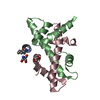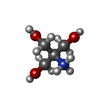[English] 日本語
 Yorodumi
Yorodumi- PDB-8qu4: NF-YB/C Heterodimer in Complex with a 13-mer NF-YA-derived Peptid... -
+ Open data
Open data
- Basic information
Basic information
| Entry | Database: PDB / ID: 8qu4 | ||||||
|---|---|---|---|---|---|---|---|
| Title | NF-YB/C Heterodimer in Complex with a 13-mer NF-YA-derived Peptide Stabilized with C8-Hydrocarbon Linker in an alternative binding pose | ||||||
 Components Components | (Nuclear transcription factor Y subunit ...) x 3 | ||||||
 Keywords Keywords | TRANSCRIPTION / Peptidometic inhibitor | ||||||
| Function / homology |  Function and homology information Function and homology informationCCAAT-binding factor complex / ATF6 (ATF6-alpha) activates chaperone genes / ATF4 activates genes in response to endoplasmic reticulum stress / FOXO-mediated transcription of cell death genes / Activation of gene expression by SREBF (SREBP) / cellular response to leukemia inhibitory factor / PPARA activates gene expression / protein-DNA complex / RNA polymerase II transcription regulator complex / rhythmic process ...CCAAT-binding factor complex / ATF6 (ATF6-alpha) activates chaperone genes / ATF4 activates genes in response to endoplasmic reticulum stress / FOXO-mediated transcription of cell death genes / Activation of gene expression by SREBF (SREBP) / cellular response to leukemia inhibitory factor / PPARA activates gene expression / protein-DNA complex / RNA polymerase II transcription regulator complex / rhythmic process / protein folding / DNA-binding transcription activator activity, RNA polymerase II-specific / DNA-binding transcription factor binding / transcription by RNA polymerase II / DNA-binding transcription factor activity, RNA polymerase II-specific / RNA polymerase II cis-regulatory region sequence-specific DNA binding / DNA-binding transcription factor activity / protein heterodimerization activity / regulation of DNA-templated transcription / regulation of transcription by RNA polymerase II / chromatin / positive regulation of DNA-templated transcription / positive regulation of transcription by RNA polymerase II / DNA binding / nucleoplasm / nucleus Similarity search - Function | ||||||
| Biological species |  Homo sapiens (human) Homo sapiens (human) | ||||||
| Method |  X-RAY DIFFRACTION / X-RAY DIFFRACTION /  SYNCHROTRON / SYNCHROTRON /  MOLECULAR REPLACEMENT / Resolution: 1.38 Å MOLECULAR REPLACEMENT / Resolution: 1.38 Å | ||||||
 Authors Authors | Arbore, F. / Durukan, C. / Klintrot, C.I.R. / Grossmann, T.N. / Hennig, S. | ||||||
| Funding support | European Union, 1items
| ||||||
 Citation Citation |  Journal: Chembiochem / Year: 2024 Journal: Chembiochem / Year: 2024Title: Binding Dynamics of a Stapled Peptide Targeting the Transcription Factor NF-Y. Authors: Durukan, C. / Arbore, F. / Klintrot, R. / Bigiotti, C. / Ilie, I.M. / Vreede, J. / Grossmann, T.N. / Hennig, S. #1: Journal: Acta Crystallogr.,Sect.D / Year: 2012 Title: Towards automated crystallographic structure refinement with phenix.refine. Authors: Afonine, P.V. / Grosse-Kunstleve, R.W. / Echols, N. / Headd, J.J. / Moriarty, N.W. / Mustyakimov, M. / Terwilliger, T.C. / Urzhumtsev, A. / Zwart, P.H. / Adams, P.D. #2: Journal: Acta Crystallogr D Struct Biol / Year: 2019 Title: Macromolecular structure determination using X-rays, neutrons and electrons: recent developments in Phenix. Authors: Dorothee Liebschner / Pavel V Afonine / Matthew L Baker / Gábor Bunkóczi / Vincent B Chen / Tristan I Croll / Bradley Hintze / Li Wei Hung / Swati Jain / Airlie J McCoy / Nigel W Moriarty ...Authors: Dorothee Liebschner / Pavel V Afonine / Matthew L Baker / Gábor Bunkóczi / Vincent B Chen / Tristan I Croll / Bradley Hintze / Li Wei Hung / Swati Jain / Airlie J McCoy / Nigel W Moriarty / Robert D Oeffner / Billy K Poon / Michael G Prisant / Randy J Read / Jane S Richardson / David C Richardson / Massimo D Sammito / Oleg V Sobolev / Duncan H Stockwell / Thomas C Terwilliger / Alexandre G Urzhumtsev / Lizbeth L Videau / Christopher J Williams / Paul D Adams /    Abstract: Diffraction (X-ray, neutron and electron) and electron cryo-microscopy are powerful methods to determine three-dimensional macromolecular structures, which are required to understand biological ...Diffraction (X-ray, neutron and electron) and electron cryo-microscopy are powerful methods to determine three-dimensional macromolecular structures, which are required to understand biological processes and to develop new therapeutics against diseases. The overall structure-solution workflow is similar for these techniques, but nuances exist because the properties of the reduced experimental data are different. Software tools for structure determination should therefore be tailored for each method. Phenix is a comprehensive software package for macromolecular structure determination that handles data from any of these techniques. Tasks performed with Phenix include data-quality assessment, map improvement, model building, the validation/rebuilding/refinement cycle and deposition. Each tool caters to the type of experimental data. The design of Phenix emphasizes the automation of procedures, where possible, to minimize repetitive and time-consuming manual tasks, while default parameters are chosen to encourage best practice. A graphical user interface provides access to many command-line features of Phenix and streamlines the transition between programs, project tracking and re-running of previous tasks. | ||||||
| History |
|
- Structure visualization
Structure visualization
| Structure viewer | Molecule:  Molmil Molmil Jmol/JSmol Jmol/JSmol |
|---|
- Downloads & links
Downloads & links
- Download
Download
| PDBx/mmCIF format |  8qu4.cif.gz 8qu4.cif.gz | 113.4 KB | Display |  PDBx/mmCIF format PDBx/mmCIF format |
|---|---|---|---|---|
| PDB format |  pdb8qu4.ent.gz pdb8qu4.ent.gz | 71.5 KB | Display |  PDB format PDB format |
| PDBx/mmJSON format |  8qu4.json.gz 8qu4.json.gz | Tree view |  PDBx/mmJSON format PDBx/mmJSON format | |
| Others |  Other downloads Other downloads |
-Validation report
| Summary document |  8qu4_validation.pdf.gz 8qu4_validation.pdf.gz | 468.9 KB | Display |  wwPDB validaton report wwPDB validaton report |
|---|---|---|---|---|
| Full document |  8qu4_full_validation.pdf.gz 8qu4_full_validation.pdf.gz | 469.4 KB | Display | |
| Data in XML |  8qu4_validation.xml.gz 8qu4_validation.xml.gz | 10.2 KB | Display | |
| Data in CIF |  8qu4_validation.cif.gz 8qu4_validation.cif.gz | 13.1 KB | Display | |
| Arichive directory |  https://data.pdbj.org/pub/pdb/validation_reports/qu/8qu4 https://data.pdbj.org/pub/pdb/validation_reports/qu/8qu4 ftp://data.pdbj.org/pub/pdb/validation_reports/qu/8qu4 ftp://data.pdbj.org/pub/pdb/validation_reports/qu/8qu4 | HTTPS FTP |
-Related structure data
| Related structure data |  8qu2C  8qu3C C: citing same article ( |
|---|---|
| Similar structure data | Similarity search - Function & homology  F&H Search F&H Search |
- Links
Links
- Assembly
Assembly
| Deposited unit | 
| ||||||||||||
|---|---|---|---|---|---|---|---|---|---|---|---|---|---|
| 1 |
| ||||||||||||
| Unit cell |
|
- Components
Components
-Nuclear transcription factor Y subunit ... , 3 types, 3 molecules ABC
| #1: Protein/peptide | Mass: 1748.177 Da / Num. of mol.: 1 / Source method: obtained synthetically / Source: (synth.)  Homo sapiens (human) / References: UniProt: P23511 Homo sapiens (human) / References: UniProt: P23511 |
|---|---|
| #2: Protein | Mass: 10876.456 Da / Num. of mol.: 1 Source method: isolated from a genetically manipulated source Details: GP is a carryover. / Source: (gene. exp.)  Homo sapiens (human) / Gene: NFYB, HAP3 / Production host: Homo sapiens (human) / Gene: NFYB, HAP3 / Production host:  |
| #3: Protein | Mass: 11258.227 Da / Num. of mol.: 1 Source method: isolated from a genetically manipulated source Details: GP is a carryover from the Precission cleavage site Source: (gene. exp.)  Homo sapiens (human) / Gene: NFYC / Production host: Homo sapiens (human) / Gene: NFYC / Production host:  |
-Non-polymers , 3 types, 92 molecules 




| #4: Chemical | ChemComp-EDO / |
|---|---|
| #5: Chemical | ChemComp-TRS / |
| #6: Water | ChemComp-HOH / |
-Details
| Has ligand of interest | N |
|---|---|
| Has protein modification | Y |
-Experimental details
-Experiment
| Experiment | Method:  X-RAY DIFFRACTION / Number of used crystals: 1 X-RAY DIFFRACTION / Number of used crystals: 1 |
|---|
- Sample preparation
Sample preparation
| Crystal | Density Matthews: 1.64 Å3/Da / Density % sol: 25.3 % / Description: 100x50 micron rod-like crystal. |
|---|---|
| Crystal grow | Temperature: 293.15 K / Method: vapor diffusion, hanging drop / pH: 9 Details: 100 mM Morpheus buffer system 3 pH 9, 30% Morpheus precipitant mix 1, 100 mM Morpheus Carboxylic acids |
-Data collection
| Diffraction | Mean temperature: 100 K / Serial crystal experiment: N |
|---|---|
| Diffraction source | Source:  SYNCHROTRON / Site: SYNCHROTRON / Site:  Diamond Diamond  / Beamline: I04 / Wavelength: 0.9537 Å / Beamline: I04 / Wavelength: 0.9537 Å |
| Detector | Type: DECTRIS EIGER2 XE 16M / Detector: PIXEL / Date: Jul 27, 2023 |
| Radiation | Protocol: SINGLE WAVELENGTH / Monochromatic (M) / Laue (L): M / Scattering type: x-ray |
| Radiation wavelength | Wavelength: 0.9537 Å / Relative weight: 1 |
| Reflection | Resolution: 1.38→41.82 Å / Num. obs: 32648 / % possible obs: 94.69 % / Redundancy: 24.5 % / Biso Wilson estimate: 20.29 Å2 / CC1/2: 1 / CC star: 1 / Rpim(I) all: 0.01089 / Net I/σ(I): 28.52 |
| Reflection shell | Resolution: 1.38→1.43 Å / Redundancy: 20.6 % / Mean I/σ(I) obs: 1.76 / Num. unique obs: 3329 / CC1/2: 0.784 / CC star: 0.937 / Rpim(I) all: 0.3004 / % possible all: 98.14 |
- Processing
Processing
| Software |
| ||||||||||||||||||||||||||||||||||||||||||||||||||||||||||||||||||||||||||||||||||||
|---|---|---|---|---|---|---|---|---|---|---|---|---|---|---|---|---|---|---|---|---|---|---|---|---|---|---|---|---|---|---|---|---|---|---|---|---|---|---|---|---|---|---|---|---|---|---|---|---|---|---|---|---|---|---|---|---|---|---|---|---|---|---|---|---|---|---|---|---|---|---|---|---|---|---|---|---|---|---|---|---|---|---|---|---|---|
| Refinement | Method to determine structure:  MOLECULAR REPLACEMENT / Resolution: 1.38→41.82 Å / SU ML: 0.1376 / Cross valid method: FREE R-VALUE / σ(F): 1.35 / Phase error: 20.3902 MOLECULAR REPLACEMENT / Resolution: 1.38→41.82 Å / SU ML: 0.1376 / Cross valid method: FREE R-VALUE / σ(F): 1.35 / Phase error: 20.3902 Stereochemistry target values: GeoStd + Monomer Library + CDL v1.2
| ||||||||||||||||||||||||||||||||||||||||||||||||||||||||||||||||||||||||||||||||||||
| Solvent computation | Shrinkage radii: 0.9 Å / VDW probe radii: 1.1 Å / Solvent model: FLAT BULK SOLVENT MODEL | ||||||||||||||||||||||||||||||||||||||||||||||||||||||||||||||||||||||||||||||||||||
| Displacement parameters | Biso mean: 27.65 Å2 | ||||||||||||||||||||||||||||||||||||||||||||||||||||||||||||||||||||||||||||||||||||
| Refinement step | Cycle: LAST / Resolution: 1.38→41.82 Å
| ||||||||||||||||||||||||||||||||||||||||||||||||||||||||||||||||||||||||||||||||||||
| Refine LS restraints |
| ||||||||||||||||||||||||||||||||||||||||||||||||||||||||||||||||||||||||||||||||||||
| LS refinement shell |
|
 Movie
Movie Controller
Controller


 PDBj
PDBj




